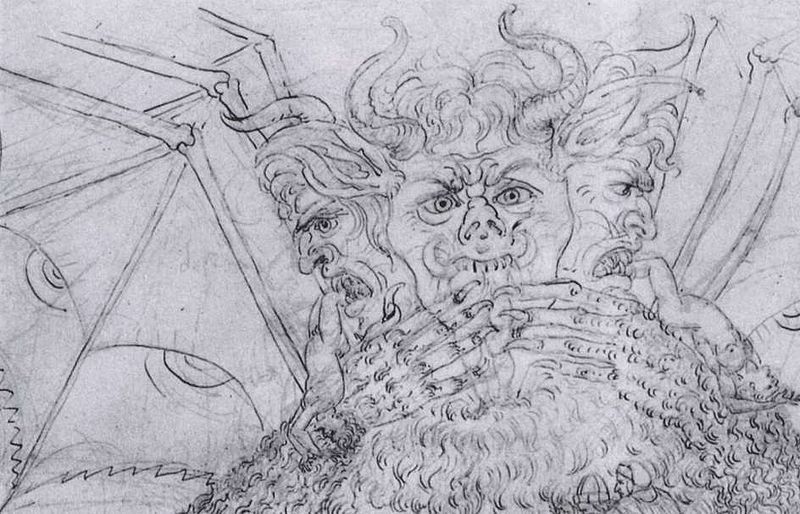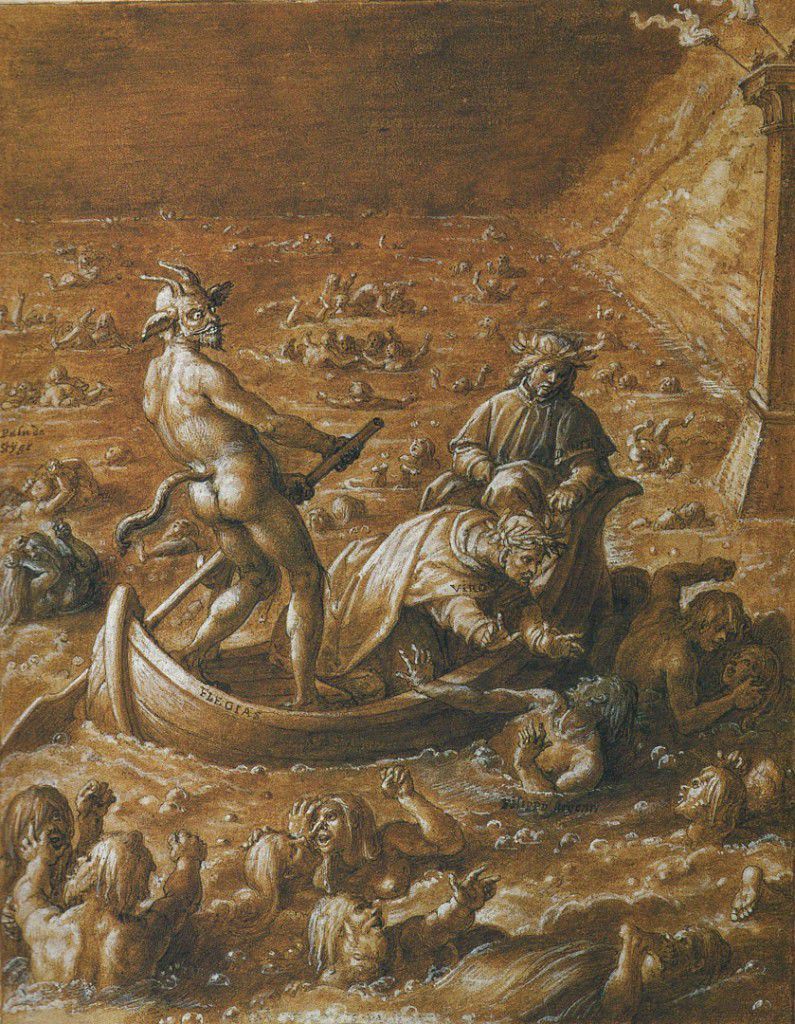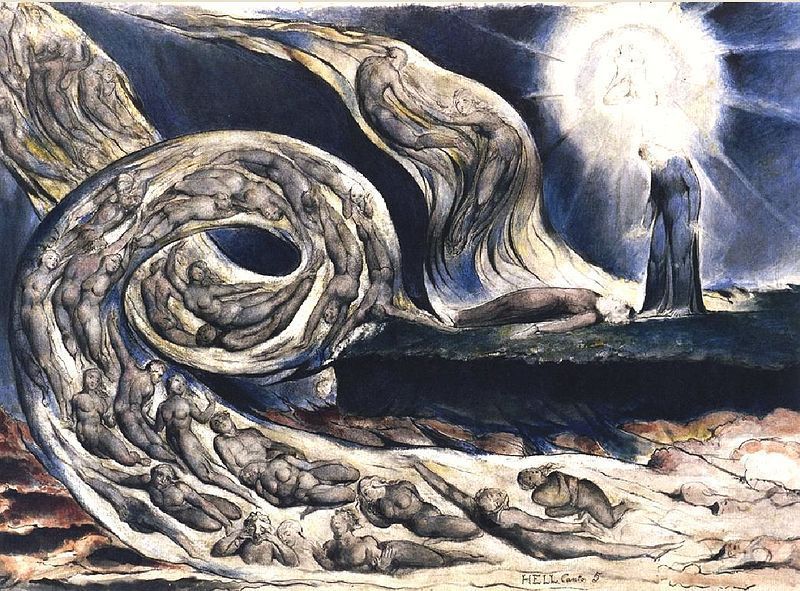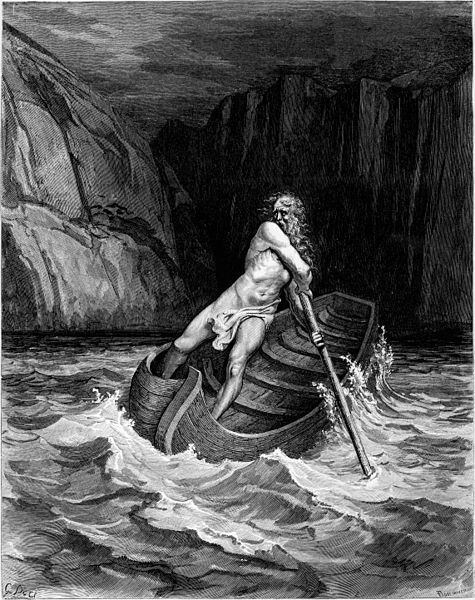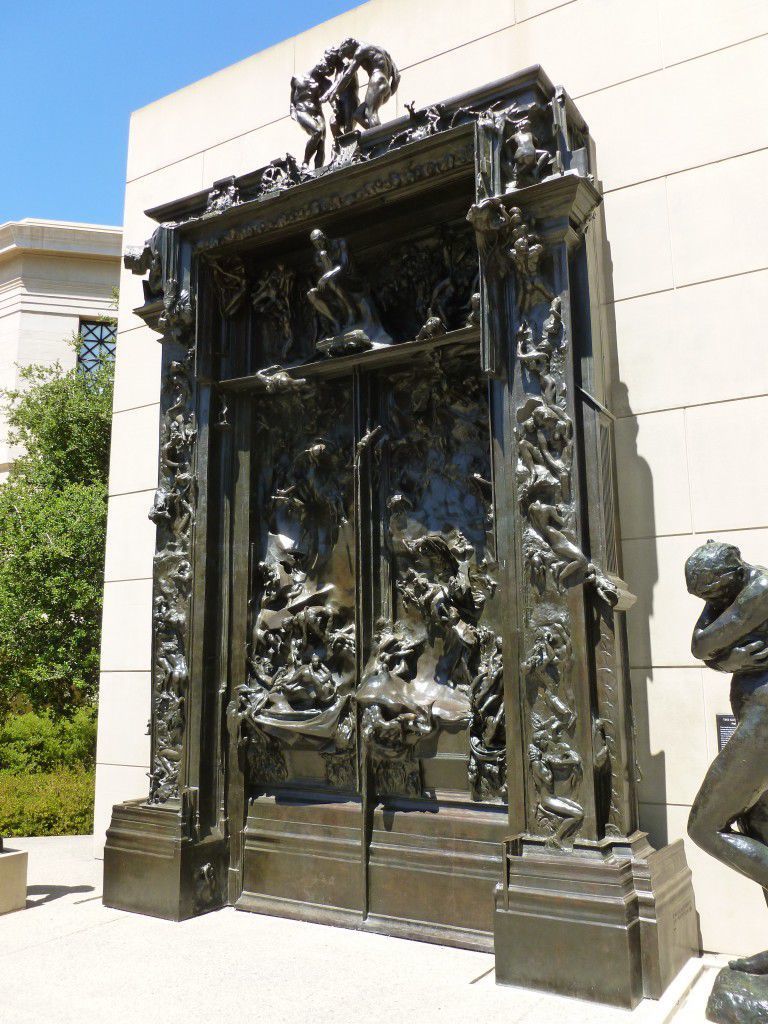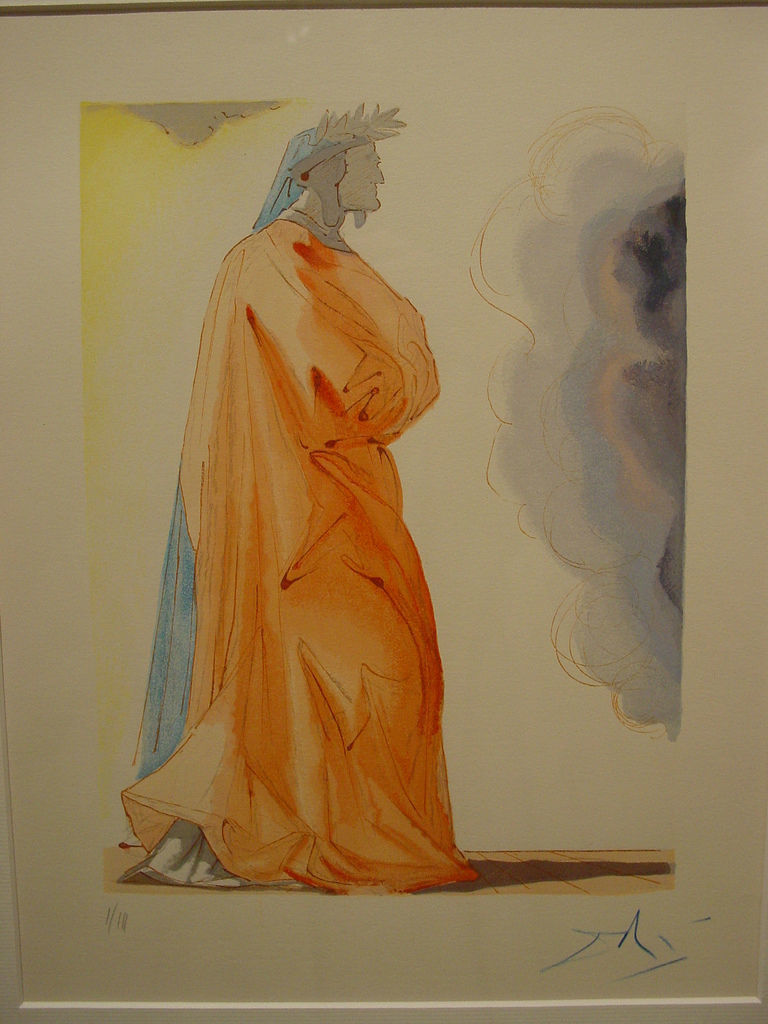The following is a selection of artists whose works of art have been inspired by The Divine Comedy of Dante Alighieri.
Sandro Botticelli (1445 -1510)
In 1550, Giorgio Vasari wrote that
Since Botticelli was a learned man, he wrote a commentary on part of Dante’s poem, and after illustrating the Inferno, he printed the work.
It is noteworthy that the first commented edition of The Divine Comedy was published in Florence in 1481, at which time the popularity of this poem was growing. Botticelli illustrated The Divine Comedy for Lorenzo di Pierfrancesco dei Medici (who also owned the Primavera) between 1490 and 1496.
The work was unprecedented. While it was customary to illustrate books with a few small images and give predominance to the text, Botticelli instead created illustrations that were similar to paintings, numerous and large, to accompany each canto of the poem. Botticelli was extremely faithful to Dante’s text and was very precise in devoting illustrations to every scene that he considered of utmost interest.
Botticelli also drew a highly detailed map of the Underworld along with a frightening portrait of Satan on a double sheet.The famous Map of Hell is the most accurate representation of the structure of Dante’s hell, and has been interpreted in many ways over the centuries. Some say it still hides something yet to be discovered…
These drawnings have since been dispersed; some lie in the Vatican Museum, while others are housed in the museums of Berlin. They are comparable stylistically to his later works because they are full of archaic elements and because the figures therein do not contain traits of realism.
Botticelli’s evident admiration for Dante is exemplified in a portrait of Dante that he created in 1495, still very famous today. It is believed that this portrait was meant to adorn the library of a scholar.
Stradanus (Giovanni Stradano) (1523 -1605)
By this name is known the Flemish painter Jan van der Straet. Sradanus lived in Florence and became intimate with the Medici family. Along with Vasari, Stradanus contributed to the realization of the Studiolo of Francesco I with two paintings, one of which is The Alchemist’s Studio.
Although he was among the leaders of Italian Mannerism, he did not forgot his Flemish origin. In fact, these two cultural components are very present in the series of illustrations on The Divine Comedy, produced between 1587 and 1588, and preserved in the Laurentian Library in Florence.
The Nordic component is revealed primarily in the illustrations of the Inferno that contain certain demonic figures or in some horrid landscapes.
In 1587, he was commissioned to paint a series of scenes of the damned in the various
Circles of Hell, along with a series of illustrations and maps.
In Inferno, Dan Brown refers to the illustration of Canto 8 by Stradanus. In that canto, the wrathful and slothful are punished. It is at this point that Dante and Virgil cross the river Styx with the help of the infernal ferryman Phlegyas.
William Blake (1757 – 1827)
The 102 drawings illustrating Dante’s Divine Comedy were commissioned to Blake in 1825. After his death in 1827, they were found in various stages of completion.
In these illustrations Blake paid close attention to the details of Dante’s poem, but also brought his own perspective to some of Dante’s central themes, including sin, guilt, punishment, revenge, and salvation. Blake’s imagery sometimes betrays a critical attitude toward Dante, but also coexists with many signs of intellectual sympathy.
Paul Gustave Doré (1832 – 1883)
Doré was a French illustrator and painter of great renown. Having begun to draw at the age of 16, he eventually worked as an illustrator first for newspapers and then for publishing houses.
He became renown and appreciated for employing a style that mixed elements of realism and romanticism. His work was also praised for its perfection of figures.
In 1865 he published an illustrated edition of the Bible, which was a huge success.
Already in 1855 Doré had planned to devote a series of illustrations to classical world literature, beginning with The Divine Comedy of Dante Alighieri (Doré’s list of illustrated works included Homer, Ossian, Byron, and Goethe). He realized the project between 1861 and 1868.
Doré had such admiration for Dante that he decided to self-finance the first book Inferno.
The admiration for Dante was widespread in mid-nineteenth century France, and as such, Doré’s illustrated book was met with immediate success.
Consequently, the publishing house Hachette published the two books Purgatory and Paradise in one volume in 1868, and in subsequent years, the edition of The Divine Comedy illustrated by Gustave Doré was translated into many languages.
The illustrations of The Divine Comedy by Doré are masterpieces. The artist had the uncanny ability to put himself in the place of Dante, almost as if the two were familiar. Some went as far as suggesting that there existed a telepathy between them…
In any case, it can be said that while Dante invented the structure of the afterlife as it is understood today, Doré was able to bring this structure to life through his illustrations. Today, those who can picture scenes from The Divine Comedy have probably seen a drawing by Gustave Doré.
William Bouguereau (1825 – 1905)
This author produced many realistic paintings on mythological and religious themes.
Unfortunately, his art was not appreciated during his lifetime because of his rejection of the Impressionist and Avant-garde movements. While he is best known for paintings such as L’Amour et Psyche, he is also the author of Dante and Virgil in Hell, the painting that ties him to The Divine Comedy.
In Canto VII, Dante and Virgil encounter falsifiers, which include alchemists, counterfeiters, perjurers, and imposters.
Capocchio, a heretic and alchemist, is attacked and bitten on the neck by Gianni Schicchi, who had usurped the identity of a dead man to fraudulently claim his inheritance.
They smote each other not alone with hands,/But with the head and with the breast and feet,/Tearing each other piecemeal with their teeth.
(Inferno, Canto 7)
Auguste Rodin (1840 – 1917)
Auguste Rodin claimed that he never went anywhere without a copy the Divine Comedy in his pocket.
This French sculpter was fascinated by Dante’s ability to “sculpt” his characters through language.
The work that bound Rodin to Dante is the Gates of Hell. It was commissioned in 1880 and remains unfinished.
Rodin decided to make a portal, a subject that had yet to be taken up, and chose to represent Dante’s hell using sketches that he had been working on for years. It is clear that he had been inspired by the famous Gates of Paradise in the Baptistry of Florence.
On top of the door stand three Shades, which work to effect, in a procedure most modern, the threefold repetition of the same figure devoid of an arm. The Thinker (Dante himself) stands above the abyss. On the door on the right is the recognizable figure of Count Ugolino.
On the left, Paolo and Francesca are inserted into a roll of bodies. The whole emerges from bubbling lava. The convulsive gestures express despair, pain, and punishment.
Rodin created approximately 227 figures, not withstanding hundreds of preparatory drawings.
Franz Von Bayros (1866 – 1924)
Franz von Bayros, illustrator, author of Ex Libris, and Austrian painter, is famous mainly for his illustrations of erotic books, including The Divine Comedy (Vienna, 1921) and classics on erotic world literature (the Decameron of Boccaccio, Berlin, 1910; Tales from the Thousand and One Nights, Berlin, 1913).
Bayros’s tortured souls huddling beneath a hail-like torrent of scalding pellets and droplets of fire
(Dan Brown, Inferno)
Dan Brown refers to the illustration of the Inferno’s 7th Circle (violence): Dante and Virgil pass trough the forest of suicides and find a desert of red hot sand where never ending flakes of fire fall slowly.
In these illustrations, Bayros’s richly detailed, suffused, pre-Raphaelite style, evidenced in The Divine Comedy, incorporates the more sophisticated influence of Gustav Klimt, Alphonse Mucha and Koloman Moser, which marked the birth of the new century.
Salvador Dalì (1904 -1989)
In 1951, Dalì was commissioned to create a set of illustrations for The Divine Comedy on the occasion of the 700th birthday of Dante Alighieri. He realized the work as watercolours and woodcuts, and his illustrations are a masterpiece in their own right.
Through Dalì’s 100 illustrations, one can find the dreams and hallucinations typical of the style of Dalì and the rawness and materiality of Dante’s Inferno.
Dalì does not only want to illustrate The Divine Comedy, but to also convey all the emotions and feelings that led Dante to create his afterlife.
Dalì’s illustrations were created between 1950 and 1959 and were immediately regarded as his most important illustrative work.
Pictures by Wikimedia, Archigeek and Pictify.com


